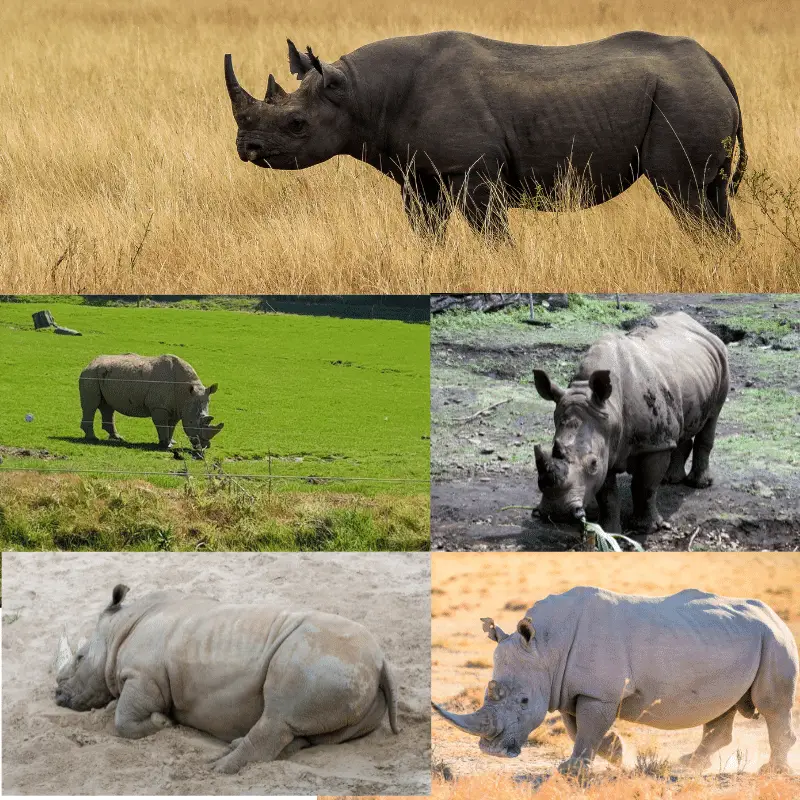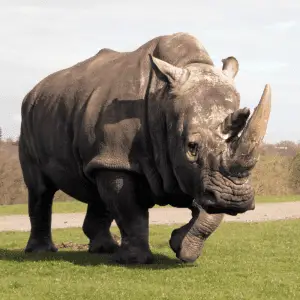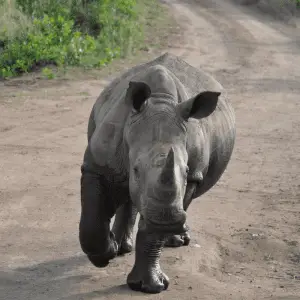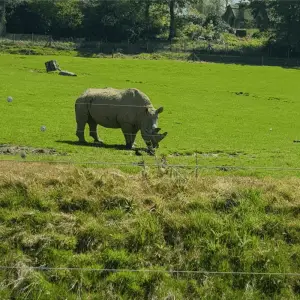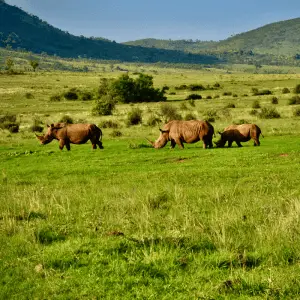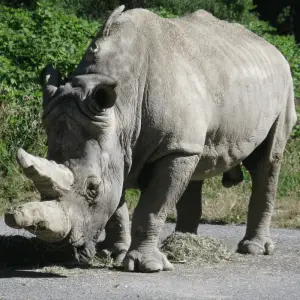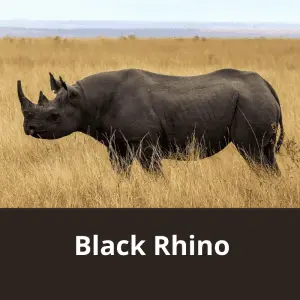There are five different rhinoceros roaming in various parts of this world. In the following article, I put together all the essential information about each rhino species, including Sumatran, Javan, Greater One-horned rhino, also known as the Indian rhino, Black and white rhinos.
1. Sumatran Rhinoceros
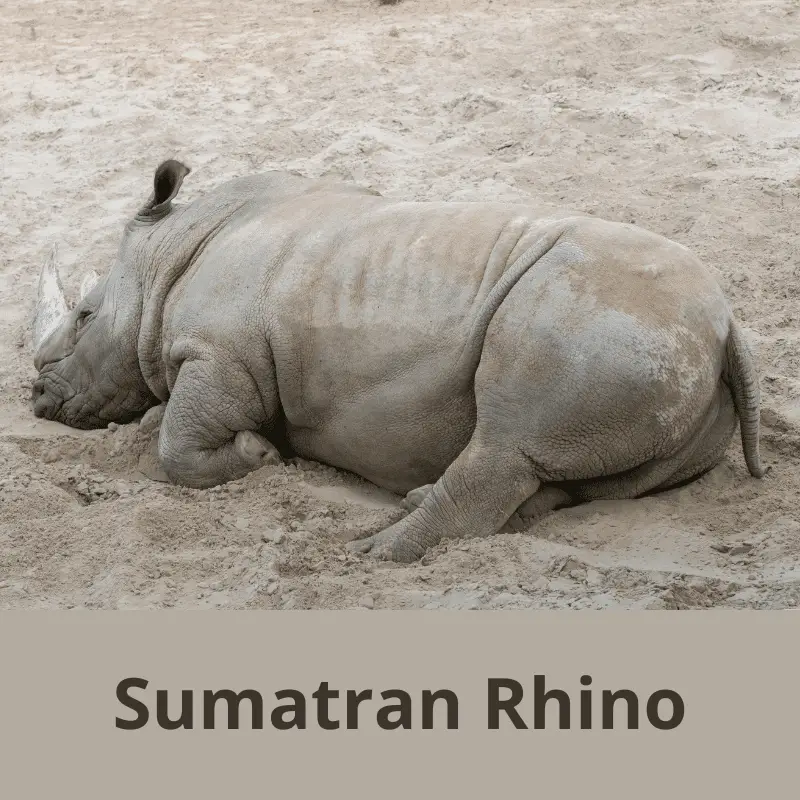
Sumatran rhinoceros can be found in the islands of Sumatra, Indonesia. In 1986 researchers believed that about 800 Sumatran rhinoceros lived in the wild. However, these days, it is estimated that only about 80 Sumatran rhinoceros can be found in the wild. Some people even found this number optimistic. According to them, there are not more than 30 individual rhinoceros that can be found in the Sumatran wild.
Location: Indonesia
Amount: Roughly 80 left in the world
Among all the rhinoceros species, the Sumatran rhinoceros had the worst luck. Climate change has impacted the rhinoceros population of this species significantly.
As long as 9000 years ago, the number of Sumatran rhinoceros was impacted by severe climate change. Since then, this rhinoceros species have not been able to bounce back.
In recent times, along with the poaching threat, human-animal conflict and widespread habitat loss have fragmented the surviving animals, making it challenging to meet and greet in the wild.
Threats: climate change and poaching
Physical Features
Sumatran rhinos are the smallest rhino species. Their weight ranges between 500 to 900 kg, and their height is about 1.45 metres at shoulder height. Unlike most rhinos, the Sumatran variety has reddish-brown skin.
Size: Smallest rhino specie
Colour: Reddish-brown skin
Sumatran rhinoceros is one of the hairiest rhino species. However, the length of the coat varies significantly between the wild rhinoceros and the ones in captivity. As the abrasion from the vegetation is less in captivity, you can find a shaggy coat of hair on these rhinoceros living in captivity.
The Sumatran rhinoceros is also the only two-horned rhinoceros species that you can find in Asia. The front horn is more prominent. It typically grows 15 to 25 cm in length.
Horns: Two
Apart from their hairy bodies and small size, the Sumatran rhinoceros can be differentiated from others with the help of their unique skin folds.
These rhinoceroses have two prominent folds in their bodies that circle behind the front leg and through the hind legs.
Unlike other rhinoceros species, the skin of the Sumatran rhinoceros is softer. There are lesser folds that you can notice near the base of the legs and the rhinoceros’ neck. Their upper lip also gives them a distinct look to the other rhino species.
Skin: Softest out of the five species
Thanks to its smaller size and lighter bodyweight, Sumatran rhinoceroses can run very fast. As these Rhinos are found in the hilly region of Sumatra, they can climb mountains easily and master the steep slopes of riverbanks without any trouble.
Run Speed: 25 MPH (40km/h)
The folds of the skin and the rhinos’ horns help these gigantic animals move through the densest vegetation.
Habitat And Location
Twenty small rhinoceros species can only be found in a few places in Sumatra and the Borneo Islands.
Location: Sumatra and the Borneo Islands in Indonesia
The rhinos love to live in the dense forest of both the island and the lowland of Sumatra.
Rhinos have evolved to live a comfortable life in the densest tropical forest of Sumatra and Borneo Island. These rhinoceros primarily live in areas where fruits, shrubs, leaves, shoots, and roots are plentiful.
Diet: Herbivore
Territory And Social Behaviour
Like a rhino species, the Sumatran rhino also lives a solitary life. Only the females with tiny babies live together. You can spot a couple of adult rhinos staying close to each other during the mating season.
Like all the rhino species, the Sumatran rhino is also very territorial. Male rhinoceroses often create a larger territory compared to their female counterparts.
The territory of two male Sumatran rhinos can overlap with each other. The male Sumatran rhinoceros mark their territory using their faeces and urine.
Just like the male Sumatran rhinos, the females also mark their territory in the wild. However, the female rhinoceros’ territorial area is much smaller than its male counterparts.
Even though rhinoceroses try to create their territory away from each other, sometimes the territory of the female rhinoceros overlaps with the male ones.
Compared to the other rhino species, the Sumatran rhinos are incredibly vocal. They communicate with each other by making various kinds of sounds.
They also create dung heaps that work as a communication point between the rhinos.
The Sumatran rhinoceros use a network of trails that connect all their area’s rivers and regions. The tracks that these rhinoceroses make while moving from one place to the next are pretty well defined.
These trails help the rhinoceroses and other animals to move from one feeding area to the next. That creates an easy passage for the other larger animals, especially the elephants and other rhinos. It also makes it easier for others to find salt licks easily.
2. Javan Rhinoceros
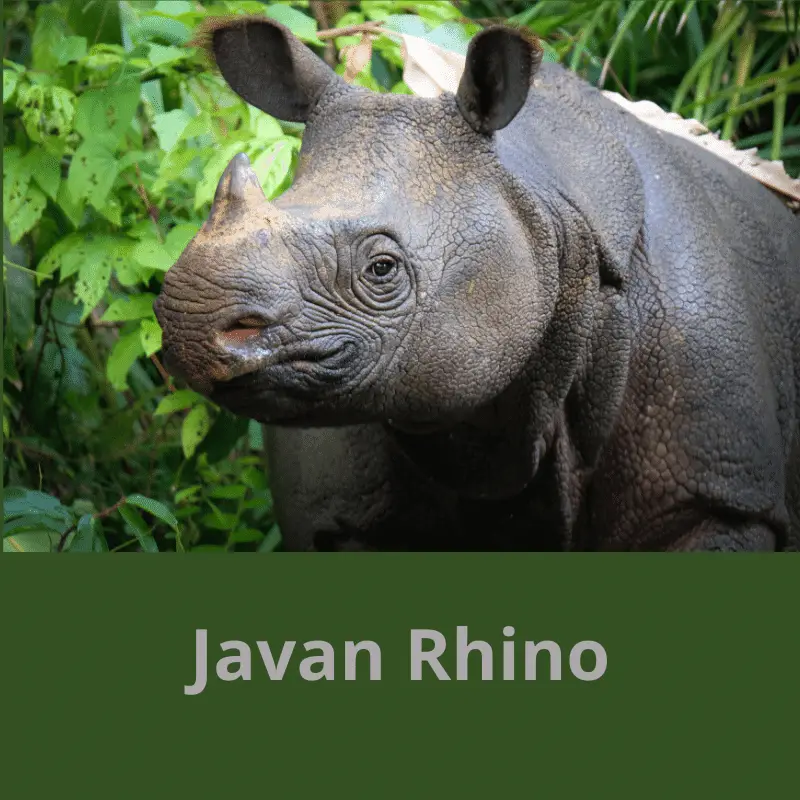
Among all the five different rhinoceros species, the Javan rhinoceros is the most valuable one right now.
Location: Protected national park of Java
Only about 60 individual animals live in the single National Park in Java, Indonesia.
The last Javan rhinoceros located in Vietnam was sadly poached in 2010.
Even though these rhinoceroses previously were found throughout South East Asia and the North-Eastern part of India, they are now only located in a single national park of Java.
Right now, the most important and perhaps the biggest threat to the survival of Javan rhinoceros is their small population size.
The researchers are afraid that the small population will lead to inbreeding which will, in turn, lead to loss of vitality and genetic variability.
Even though the two habitats where the Javan rhinoceroses are currently living are pretty secure, the number of rhinos living in the area is far too small for the long-term survival of this species.
Along with poaching, the loss of habitat due to agriculture and development has created threats for this rhinoceros.
Threats: Poaching and loss of habitat
Diet: Herbivore
Habitat loss is not a limiting factor overall, but the rhinoceros species’ two habitats are not large enough to encourage significant population growth. The only way to save this species is to re-establish them in areas where they have been exterminated.
Physical Features
The Javan rhinoceros is a smaller and lighter cousin of the Indian one-horned rhinoceros. The height of these rhinos is about 1.7 m shoulder height.
The information collected from The Skeleton Museum of Indonesia indicates that the female Java rhinoceros might be a little bit bigger than the male one.
The size of the Javan rhinoceros is quite comparable to the African black rhino.
The weight of these rhinos ranges from 900 kg to 2300 kg.
Like other rhinoceros species, the Javan rhinoceroses also have greyish-brown skin.
Diet: Herbivore
Skin Colour: Greyish-brown skin
They have a single horn that usually grows 20 cm in length. Compared to the female rhinoceros, the males often have more prominent horns. Many females do not develop any horns during their lifetime.
The rhinoceros horn can grow back if it is broken off.
The horn of the Javan rhinoceros is not just for fighting. Most of the time, they use their horns for protecting their head while breaking through dense vegetation.
Horn: One
Like all the other Asian Rhinos, Javan rhinos also have long jagged, light lower incisor teeth used for fighting.
The Javan rhinoceroses have a perfect sense of smell. Just like other rhino species, these rhinoceroses are also short-sighted.
One of the distinct physical features of the Java rhino is its long pointed upper lip. These rhinoceros often used their upper lip to grasp their food.
Eyesight: Poor
Sense of Smell: Strong
The Javan rhinoceros has more minor neck folds. However, they have a vast two-folds of skin on the back of their neck, which creates a saddle-like structure on the neck and Shoulder region of these rhinoceroses.
The skin of the Javan rhino is covered with a mosaic light pattern which gives it a scale-like aesthetic.
Breathing And Social behaviour
Just like other rhino species, the Javan rhinos are also solitary animals. You can only find two rhinoceroses living together only during their courtship. Besides that, baby rhinos often stay close to their mothers for a long time.
The Javan rhinoceroses often form a more extensive territory that overlaps with other dominant males.
Female rhinoceros also form territory boundaries, but their territorial area is not as large as their male counterparts.
These rhinos often have a short period of courtship when the female is ready for mating. This is the only time when the male and female rhinoceros socialise.
Compared to their Sumatran counterpart, the Javan rhinoceroses are not as vocal. Over the period, researchers recorded only a couple of vocalisations. Like most other rhinoceros species, the Javan rhinoceros also used an indirect form of communication to interact with their other members.
Habitat And location
Even though these rhinoceroses prefer to feed on vegetation that does not grow very tall, large trees play a significant role in the lifestyle of the Javan rhinoceros. The forest offers them a cover that helps them to avoid solar radiation. Not only that, but the forest trees also provide them with saplings that are eaten by the rhinos. The optimal habitat of the rhinoceroses is like a mosaic of various types of grasses interspersed with dense forests.
3. Greater One-horned Rhinoceros (also known as the Indian Rhinoceros)
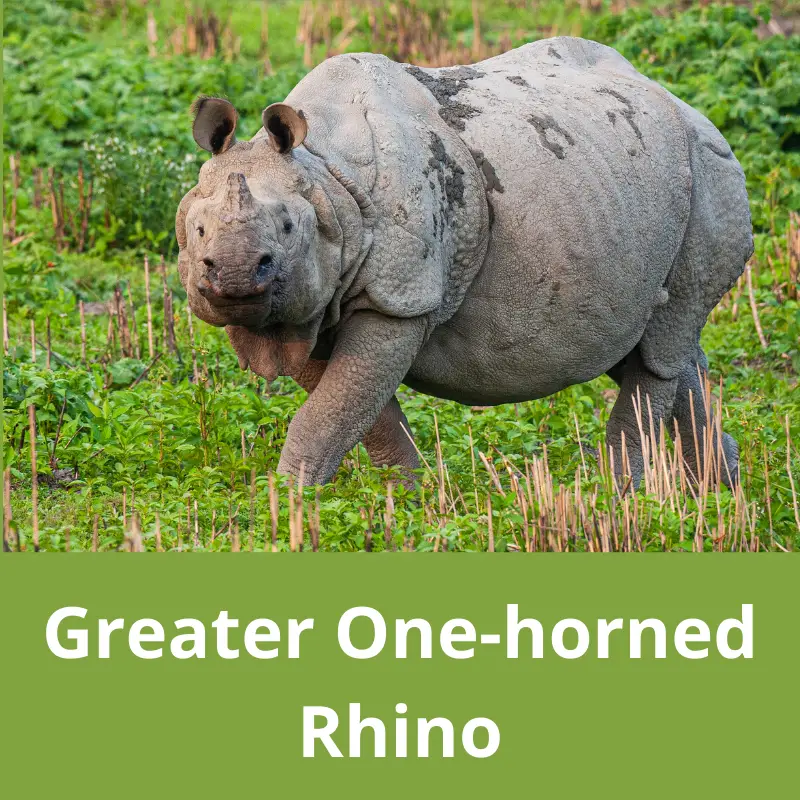
Human encroachment and human-animal conflict are the greatest threats that greater one-horned rhinoceros face today. For centuries the greater one-horned rhinos have been hunted for sports and their horns. The situation was so critical that in the early 19th century, these rhinos were hunted to almost extinction.
You can only find the remaining animals in the protected forests. However, some good news is that the number of rhinoceros residing in the reserved forest and protected areas has been growing significantly in the last few years.
Threats: Poaching and loss of habitat
Diet: Herbivore
Under strict regulation and monitoring, the greater one-horned rhinos are slowly being brought back from the brink of extinction.
Physical Features
The greater one-horned rhinoceros is the second largest of all the rhino species. Only the white rhinos of Africa are more significant than the greater one-horned rhinoceros.
The weight of these rhinos ranges between 4000 to 6000 pounds. The shoulder height of the greater one-horned rhinos stands around 2 metres.
Like most other rhino species, the skin colour of the greater one-horned rhino is grey.
Eyesight: Poor
These rhinoceroses do not have any hair on their skin. However, there are many thick folds that you can notice on the skin of the rhinoceroses.
This fold creates a structure that closely resembles armour plating. Several prominent folds around the neck region protect this area.
In certain body parts, the maximum width of the skin is more than 4 cm. Apart from that, the thickness of the subcutaneous fat of the greater one-horned rhino is about 5 cm.
Skin Thickness: 4 cm
This thick layer of subcutaneous fat is well connected with blood which helps the Rhinos in thermodilution. That means the greater one-horned rhinos can easily regulate their body temperature in different weather conditions.
However, the areas between the skin folds and the areas around their stomach and legs are pretty soft. Most of the time, the poachers will target these areas while hunting down the rhinos.
Horn: One
As the name suggests, the greater one-horned rhinoceros comes with one single horn, 20 to 61 cm long. The weight of the horn can reach up to 3 kg. The horn is created with keratin and has the same structure as the hair and nails. If the horn gets broken off, it can regrow over a while.
Habitat And Location
Right now, the greater one-horned rhinos can be found in the Himalayan foothills of Nepal and India. They often create their territory near swamps and riversides.
Location: Himalayan foothills of Nepal and India
Previously the greater one-horned rhinos roamed freely in the forest and flood plains along the Ganges Brahmaputra and Indus River Valley.
Territory And Social Behaviour
Just like all other rhino species, the greater one-horned rhinos are solitary. Male rhinoceroses form a not very well-defined area compared to the other rhinos, where they live alone.
Even though they do not mark their territory, the male rhinoceroses can get aggressive if other rhinos or giant animals try to infringe on them.
Death of the male rhinoceros due to an aggressive territorial defence is not uncommon. However, the death usually takes place only a couple of days after the fight.
Aggression: High And Dangerous
Most of the time, the rhinoceros dies from the wounds from the fight. The territory of the rhinoceros changes according to the availability of food and water.
It also changes depending on the season and the environmental condition. The females generally move in and out of their territory when and as they please.
If the food is abundant within a particular area, you can find the number of greater one-horned rhinoceroses feeding near each other.
Breeding And Birth
The female rhinoceroses start breeding when they reach about four years of age. On the other hand, male rhinoceroses take a longer time to become sexually active.
The male rhinoceroses start to mate with their female counterparts at about nine years of age. The greater one-horned rhinoceros does not have any particular breeding season.
The meeting takes place when the females showcase interest. Generally, a female rhinoceros gives birth every 3 to 5 years.
The gestation period of the rhinoceros is about 15 – 16 months. Whenever the female rhinoceros is ready to give birth, she finds a quiet and solitary space to bring her baby to the earth.
Recommended Read: Rhino Pregnancy Information
At birth, the baby rhino can weigh about 58 to 70 kg. The calf stays with her mother until she is large and robust enough to defend herself in the wild alone.
Every day a baby rhinoceros can drink about 30 litres of milk and gain about two kgs. Until they are three to five months old, the baby rhinos start to feed on vegetation and their mothers’ milk.
Even though rhinoceros’ mothers are very protective of their babies, the young babies face predation by big cats and crocodiles in the wild.
4. African Black Rhino
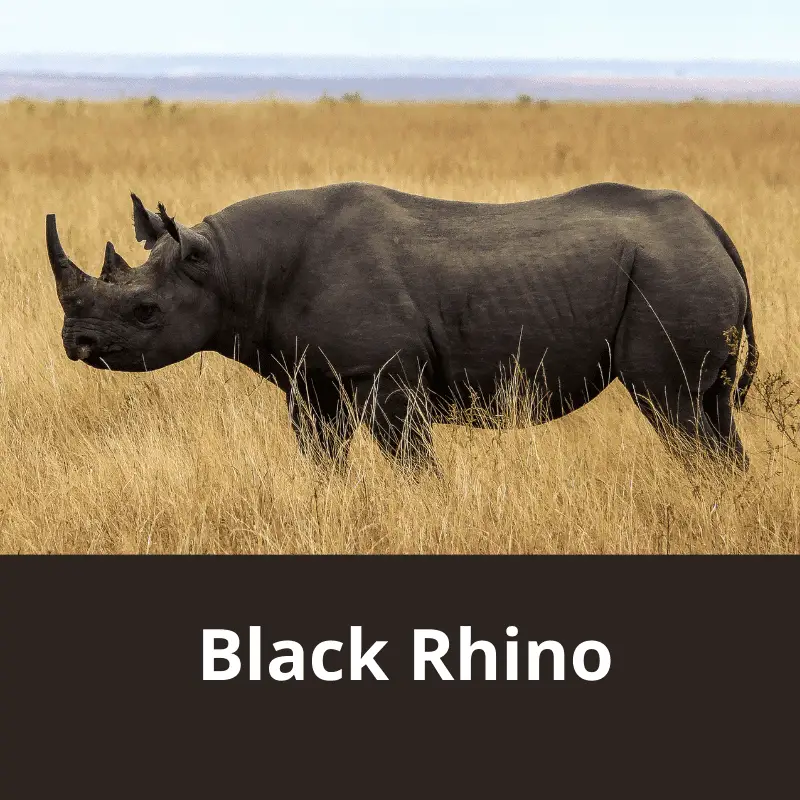
Physical Feature
Among the two African rhino species, the black rhinos are smaller. While the adult black rhinoceroses can weigh up to 1350 kgs, the females weigh about 900 kg. The shoulder height of the rhinoceros is about 1.6 m.
Even though the African rhinoceroses are differentiated according to their skin colour, they both have dark grey skin. However, the appearance of the skin varies significantly depending on the condition of the local soil. These rhinoceroses do not have anybody hair except for their ears, tails, and eyelash regions.
Skin Colour: Dark grey skin
Threats: Poaching and loss of habitat
Diet: Herbivore
The black rhinoceros have two distinct horns which can grow from their skin. The horns of the rhinoceros keep on growing throughout their life. Rhinos from different areas may sport horns of different sizes and shapes.
The shape and size of the horns of the black rhinoceros also change depending on their gender. The male rhinoceroses tend to have thicker horns compared to their female counterparts.
The female black rhinoceroses have thinner and longer horns. The horns are made of keratin, and they are very hard. However, that does not mean it cannot get broken off during fighting.
Recommended Read: Why Do Rhinos Have Horns?
The anterior horn of the rhinoceros is longer than the posterior one. The average size of the anterior horn is about 50 cm.
The less pronounced hump on their neck and the smaller size makes the Black rhinos different from the White ones. The black rhinos have a smaller head compared to the other African rhinoceros species.
Unlike their white counterparts, the black rhinos are browsers. These rhinoceroses tend to eat from the vegetation growing in the upper bushes and trees. They also have hook-shaped lips, which help them to browse. That is why the black rhinos required less neck strength than their white counterparts.
Habitat And Location
You can find black rhinos throughout Africa’s eastern and southern places, including Zimbabwe, Namibia, Tanzania, Kenya, and South Africa. African rhinoceroses recite in a range of habitats.
The only requirement of these rhinoceroses is that the habitat must support their physical needs. The population density of the rhinoceros in a particular area largely depends on the characteristics of the habitat in question. In the thicker vegetation of Namibia, you can find more than one rhinoceros per square kilometre area.
Location: Zimbabwe, Namibia, Tanzania, Kenya, and South Africa
Territory And Social Behaviour
There are two different characteristics of the black rhinos of Africa. One can be solitary and aggressive, or they can be less aggressively territorial and semi-social.
The nature of the rhinoceros largely depends on the quality of their habitat. Sharing the same reservoir proves that the black rhinoceros can be social. The black rhinos can congregate socially at waterholes.
Male rhinoceroses live in territories that are about 5 km in radius. The adult male rhinoceros tend to live alone except when they court females.
Aggression: Semi aggressive or highly aggressive depending on the rhino and the environment in which they live.
There are two types of adult male rhinoceroses spotted: the dominant and the subordinate males. Female rhinoceroses also form their territory.
Scent marking is considered an essential method of communication that these rhinoceroses use to communicate with each other.
Apart from using their urine and faeces, the black rhinos also use head rubbing to create scent marking.
Snorting and sniffing are the most common noises that the black rhino generally makes.
5. African White Rhino
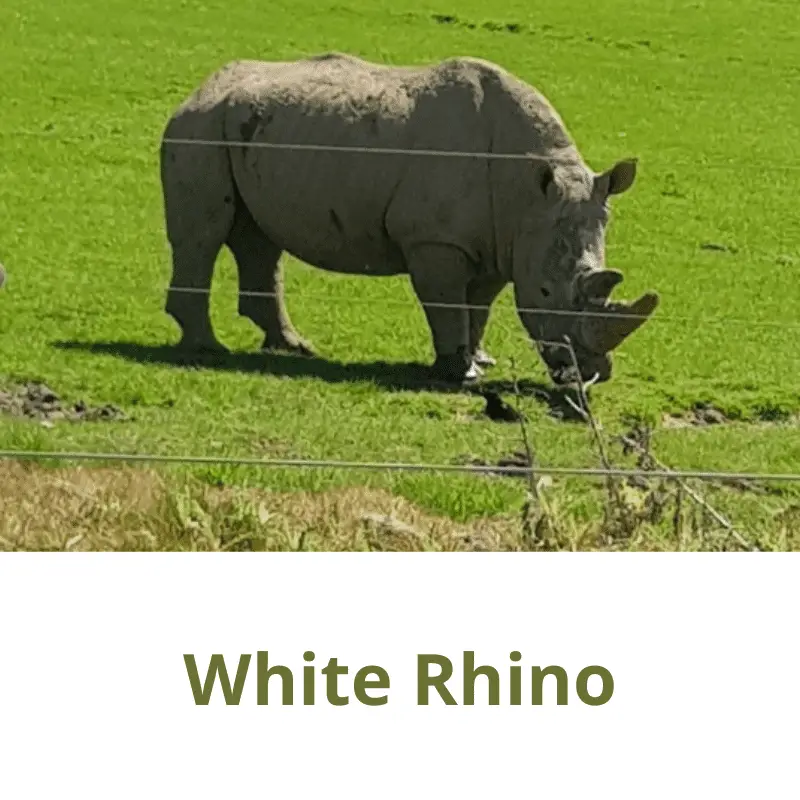
White rhinoceroses are the second-largest land mammals, next to the elephants.
Also known as the square lip rhinoceros, the white rhinos have a square-shaped upper lip that helps the animals graze.
These rhinoceroses have almost no hair on their body. You can only find patches of hair near their origin and on their tails.
Threats: Poaching and loss of habitat
Diet: Herbivore
There are two identical subspecies of white rhinos found in Africa. One is known as the Northern white rhino, and the other is the Southern white rhino.
They differ depending on the area they are located.
In March 2018, the Northern white rhinos were declared functionally extinct as the last male died. Only two northern white rhinos are left in the world, both females.
These last two female northern white rhinos rhinoceroses live in a conservation park in Kenya and are protected by armed guards. The northern white rhinos are near extinction thanks to rampant poaching of the animals for their horns.
The southern white rhino subspecies can be found in just four African countries.
- Kenya
- Zimbabwe
- Namibia
- South Africa
In the late 19th century, the southern white rhinoceroses were considered extinct. However, in 1895 a small population of Southern white rhinos was found in South Africa.
Since then, over century-long protection and management of these rhinoceroses right now, they have been declared as near threatened. Amazingly, about 18,000 white rhinos are living in the wild of Africa.
Social Structure
Compared to all other rhinoceros species, the social structure of the white rhinos is the most complex one. Even though they are physically solitary animals, sometimes they can form groups and lead as a herd.
It’s been known that a group of fourteen rhinos live together in groups in which females and baby rhinos form.
Even though the male rhinoceroses form large territories, they only aggressively protect one square mile of their territorial area. Also, mark wastage vigorously with the help of dung piles.
Compared to that, the territory of the female rhinoceroses can be more than seven times larger.
Territory Areas: Females are larger than the males
Most of the time, the breeding females are stopped from leaving the territory of a dominant male. During this period, the male white rhinoceros marks its territory regularly.
White rhinoceroses are often seen engaging in severe battles over the mating rights of the female. During the fighting, the male rhinoceros often use their horns.
What are baby rhinos predators?
- Big Cats
- Crocodiles
- African Wild Dogs
- Hyenas
What sounds do a black rhino make?
The black rhino makes a snorting and sniffing sound.
How many white rhinos are left?
Amazingly, about 18,000 white rhinos are living in the wild of Africa.

